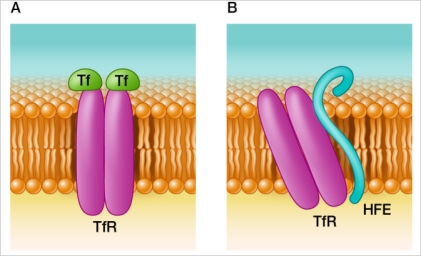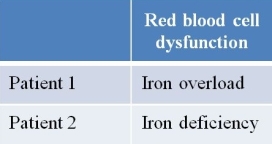Multiple Choice
Refer to the figures and table below. 
 Human blood cell membranes import iron into the cell via receptor-mediated endocytosis.They do this using transferrin receptors to bind the iron-carrier protein transferrin, which carries two Fe3+ ions per protein molecule.Panel A of the figure above shows two transferrin molecules (Tf) bound to one receptor (TfR) .Panel B shows the interaction between the regulatory protein HFE and the transferrin receptor, which results in inhibition of transferrin binding to the transferrin receptor.Genetic mutations in transferrin, transferrin receptor, or HFE can lead to red blood cell dysfunctions.How might mutations be involved in the two cases summarized in the table?
Human blood cell membranes import iron into the cell via receptor-mediated endocytosis.They do this using transferrin receptors to bind the iron-carrier protein transferrin, which carries two Fe3+ ions per protein molecule.Panel A of the figure above shows two transferrin molecules (Tf) bound to one receptor (TfR) .Panel B shows the interaction between the regulatory protein HFE and the transferrin receptor, which results in inhibition of transferrin binding to the transferrin receptor.Genetic mutations in transferrin, transferrin receptor, or HFE can lead to red blood cell dysfunctions.How might mutations be involved in the two cases summarized in the table?
A) Patient 1 has a mutation in the transferrin gene that disrupts its ability to bind iron, and patient 2 has a mutation in the transferrin receptor gene that prevents it from binding transferrin.
B) Patient 1 has a mutation in the transferrin receptor gene that prevents it from binding transferrin, and patient 2 has a mutation in the HFE gene that prevents it from binding to the transferrin receptor.
C) Patient 1 has a mutation in the HFE gene that prevents it from binding to the transferrin receptor, and patient 2 has a mutation in the transferrin receptor gene that prevents it from binding HFE.
D) Patient 1 has a mutation in the transferrin gene that disrupts its ability to bind iron, and patient 2 has a mutation in the transferrin gene that prevents it from binding to the transferrin receptor.
E) Patient 1 has a mutation in the HFE gene that prevents it from binding to the transferrin receptor, and patient 2 has a mutation in the transferrin receptor gene that prevents it from binding transferrin.
Correct Answer:

Verified
Correct Answer:
Verified
Q2: The cell membrane contains carbohydrates, which can
Q3: A protein that forms an ion channel
Q4: In facilitated diffusion, the diffusion rate of
Q5: Refer to the figure below showing the
Q6: The membrane protein that transports glucose and
Q7: Scientists have been able to engineer young
Q8: Which is the name of a specialized
Q9: Integrin on the cell surface of a
Q10: Refer to the figure below showing concentrations
Q11: Cell adhesion occurs through the interactions of<br>A)